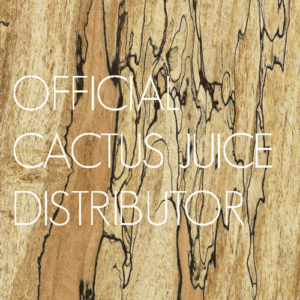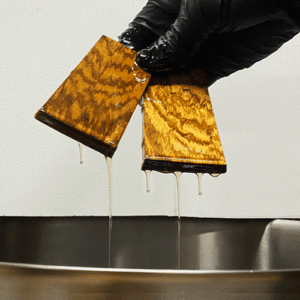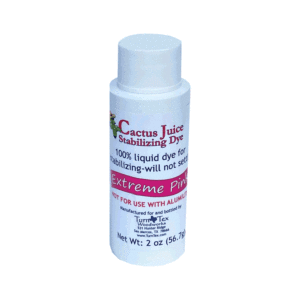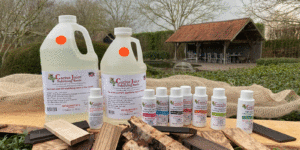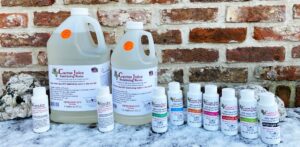FAQ’s
Frequently asked questions
This is one of the million dollar questions in stabilizing! There is no set rule since every piece and species of wood can be different. Cactus Juice itself only takes 6-8 minutes at 90°C to cure. However, the internal temperature of your wood has to reach this temp before it begins to cure. A larger piece of wood will take longer than a small piece of wood. Densities affect the cure time as well.
My suggestion is to put them in the oven for a couple of hours and then put on some leather gloves, take them out of the oven, and peel some of the foil back. If you see any liquid, immediately put them back in and cook for another hour. If you see solidified Juice, you are good to go! Don’t let them cool down and then check them. If you do that and find liquid, your blanks are now ruined. Once you interrupt the polymerization process, it can not be effectively re-started by heating again.
Your blanks should be cured right between 87° and 90° C. It is advised to use an oven thermometer to double check the temperature of your oven. If you are using a toaster oven, the dials are notoriously inaccurate. Curing hotter will not hurt the Juice but it will cause more to “bleed” out when curing. Keep it at the recommended temperature for best results!
Most any wood or other porous material can be stabilized. You will have to decided if really hard or dense woods will give you any benefit by being stabilized. If you are knife maker or call maker, stabilizing dense woods may make sense because the stabilizing will help reduce wood movement due to moisture changes. For pen makers or other who can put a CA finish on their completed items, thus sealing them against moisture absorption, it may not make a lot of sense to stabilize those hard woods.
It is best to not mess with trying to stabilize oily woods. On some woods with high oil content, the vacuum process can actually pull the oil out of the wood and then it can mix with the Cactus Juice. If the concentration is high enough, it can affect the chemistry of the Juice and cause cure issues where it may not cure properly.
It does give off some odors while curing but to me, they are not bad odors. I would not want to “cook” them in the house but I don’t think a basement shop would be an issue with it getting upstairs.
Yes, the unabsorbed resin is certainly re-usable. Some woods may discolor the resin but that would be up to the operator whether or not to use it. You can always add dye to any discolored resin and it will mask the discoloration.
Cactus Juice forms an emulsion in water. It is very easy to wash out the chamber with regular dish soap and water. I wash my chamber out after every use. The resin has a viscosity of around 8 CPS meaning that it is about the consistency of blood or kerosene (sorry, only measurement that I could find that compares!) and it does not set up unless it is heated up. You will not get any build up in the chamber.
Drying green wood can be tricky, depending on the species. I would start out by leaving them larger than you need to allow for shrinkage and warping. Then you could simply place them on a shelf in your shop for 6 months to a year. If you need to speed that up, there are many ways to do this. You can make a hot box with a 100 watt lightbulb for a heat source and allow the blanks to stay in there for a week or so. You could also do the same with a toaster oven if it will go low enough. I would be looking to keep it around 100-120° F. You could also look online for directions on drying wood in a microwave. Many folks have had good success with that method. Regardless of what method you use, once you get them “dry”, you need to further dry them to oven dry state in an oven at 220° F for a minimum of 24 hours for best stabilizing results.
I always prefer stabilizing punky wood before casting. The main reason is that with punky wood, if you cast first, the pressure will push some of the colored resin into the wood causing color bleed. I prefer the junction between the wood and casting resin to be nice and crisp and stabilizing helps seal the punky wood so you do not get the color bleed. One suggestion when stabilizing before casting though…don’t wrap the blanks in foil.
See this link for more infoYes, it works fine for bone and antler. Pretty much anything that is porous and not oily can be stabilized including wood, bone, antler, rock, plaster, etc.
First, if you are using an oil filled rotary vane pump as recommended, don’t worry about the wear and tear on the pump. They are made for continuous use and are not harmed by running for many hours at a time. The reason to keep the pump running is to keep the air moving from the wood. You are only creating a vacuum in the empty space above the blanks. If you close a valve and shut off the pump, the air coming from the blanks moves to that empty space and the level of vacuum starts to drop. If vacuum level is dropping, air flow is also dropping. You may not see it on a typical gauge but if you use a precision, micron gauge, you will see the vacuum level start dropping immediately after shutting off the pump. Think of it this way…place a straw in a coke and start sucking. As long as you are sucking on the straw, the coke is flowing. If you suck on the straw enough to get the coke to the top of the straw and then hold it, the coke stops moving. The same thing happens in the chamber in simplistic terms.
Keep the pump running and you will reduce your amount of time under vacuum compared to pulling a vacuum and then shutting off and holding it, then starting again, etc. Maximum continuous vacuum equals maximum continuous flow of the air from the wood and reduces the time to get the air out. The more air you get out of the wood, the more resin you can get back in when you release vacuum and allow the blanks to soak.
No! Cactus Juice is designed specifically for use under full vacuum. There is nothing in Cactus Juice that will “boil” or vaporize under full vacuum when using it below the use and storage temperature of 85° F. Cactus Juice can boil if the temperature of the resin is above 93° F which is outside the maximum use and storage temperate of 85° F to begin with. Also, a quality vacuum pump does not contain any rubber (or other material) seals that are in contact with the air stream and do not contain any plastic parts in the actual vacuum cartridge. Some of the cheap import pumps do but even then, Cactus Juice will have no effect on them unless you suck resin into the pump.
It is best to avoid oily woods as the oil in the wood can be pulled out during vacuum and affect the chemistry of the Cactus Juice.
Activated Cactus Juice has a shelf life of 8-12 months at room temperature. If kept in the refrigerator, it has been reported to last for 2 years. The thing about Cactus Juice and shelf life…once the shelf life has been exceeded, it will NOT cure or go hard. It just gets to where it will not cure properly or at all. If that happens, contact me and I can send me activator if you have enough to deal with and you can rejuvenate it. I DO NOT recommend trying to activate less than the entire container you purchase. The activator is a semi paste by weight and needs to be fairly precise (within a gram or two). You would have to precisely weigh it to get the proper ratio and even then, you can run into issues. My policy is that I have a 12 month shelf life guarantee from the date it ships.
Stabilising Dyes
I recommend starting out with a ratio of 1 oz per gallon of Cactus Juice. Add the dye to the Cactus Juice in a jug and shake vigorously. Then run a sample batch with the wood you plan to do to completion. After cured, cut in half lengthwise to see what the color inside looks like. If it is too dark, add clear Cactus Juice to your mix. If it is not dark enough, add more dye. Just keep in mind that it takes a LOT more dye than you think to get good color in most woods.
Hard woods will require more dye than soft punky woods. Wood color will also have an effect on the final product.
Suggested Starting Mix Ratio: 1oz per Gallon
Maximum Loading Ratio, Do Not Exceed: 4oz per Gallon
Soak your blanks in your first color with no pressure or vacuum, just let me soak. You will have to experiment with how long based on the wood you are working with. Then cure your blanks in the oven as normal. After they have cooled down do a normal, complete vacuum process with your second color.
Shipping
Yes we do! Depending on the country, delivery will be between 2 and 5 days. But we are focusing on deliveries within the European Union. There are plenty of distributors of Turntex Cactus Juice around the other continents. You can order directly with Turntex, Texas for countries outside of the EU.

